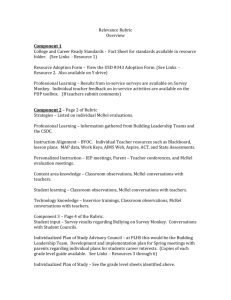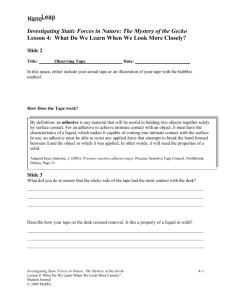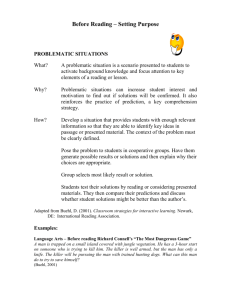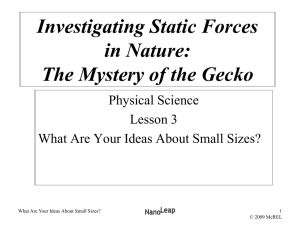+ PowerPoint
advertisement
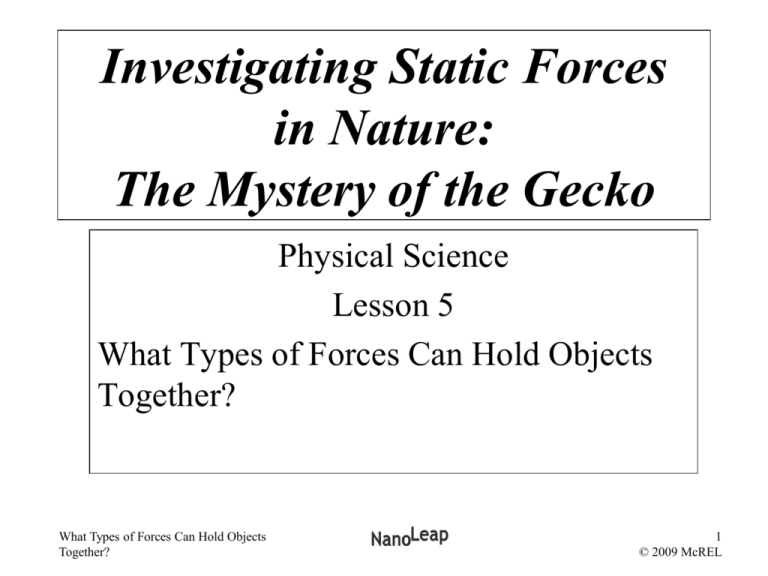
Investigating Static Forces in Nature: The Mystery of the Gecko Physical Science Lesson 5 What Types of Forces Can Hold Objects Together? What Types of Forces Can Hold Objects Together? 1 © 2009 McREL What Sticks? You will be working at several stations using an assortment of materials to test and record some ways that objects adhere to a plastic transparency. Try the suggested procedure described at each station first before exploring on your own. What Types of Forces Can Hold Objects Together? 2 © 2009 McREL What Sticks? Station Materials 1 Magnets, Paperclips, Plastic Transparency 2 Suction Cups, Plastic Transparency 3 Fur or Wool, Balloon, and Plastic Transparency Which Objects Stick Together? What Types of Forces Can Hold Objects Together? How Do They Stick Adhesion Method 3 © 2009 McREL What Sticks? Station Materials 4 Beaker of Water, Paper Towel, Plastic Transparency 5 Washers, Velcro®, Plastic Transparency 6 Transparent Tape and Plastic Transparency 7 Additional Station Which Objects Stick Together? What Types of Forces Can Hold Objects Together? How Do They Stick Adhesion Method 4 © 2009 McREL Variables 1. Choose one of the pair of objects that stuck together during your exploration. Describe factors (variables) that affect how well those two objects stick together. 2. Describe an adhesive in your own words. What are the properties that make it work? 3. Which factors or variables are testable and which are not? What Types of Forces Can Hold Objects Together? 5 © 2009 McREL Observations 4. Describe how you made observations in today’s lesson. a. What senses/tools did you use? b. What observations were at the visible scale? c. What dominant forces did you observe? d. What are other forces that you observed that may be at the invisible scale? What Types of Forces Can Hold Objects Together? 6 © 2009 McREL Adhesion Methods Method Definition Drawing Example Gecko Y/N Why/ Why Not? Friction Air Pressure Microinterlocking Magnetic Static Electricity Capillary Wet Adhesion Electrical What Types of Forces Can Hold Objects Together? 7 © 2009 McREL Making Connections 1. Describe one or two ideas that you learned during this lesson. 2. How do things stick together? 3. Which of these methods can be eliminated as an explanation for why the gecko can stick to a ceiling? 4. What should we explore next? What Types of Forces Can Hold Objects Together? 8 © 2009 McREL Flow Chart 1. How Can a Gecko Walk on a Ceiling? Scale: Visible Dominant Force: Gravity Tools: Eye 5. What Types of Forces Can Hold Objects Together? Scale: Visible/Invisible Dominant Force: Gravity Tools: Eyes and Hands 2. What Do We Mean When We Speak About Surfaces in Contact? Scale: Visible Force: Gravity Tools: Eyes 6. How MUCH Force Is Needed to Make an Object Stick? What Factors Affect the STRENGTH of Force Acting? What Types of Forces Can Hold Objects Together? 3. What Are Your Ideas About Small Sizes? Scale: Visible/Invisible Dominant Force: Varies Tools: Eyes, Instruments 7. How Do We Measure Forces at the Nano Level? 4. What Do We Learn When We Look More Closely? Scale: Invisible Dominant Force: Extremely Small, Large in Number Tools: Special instruments (scanning tunneling microscope) 8. How Can a Gecko Walk on a Ceiling? 9 © 2009 McREL
